| |

| Author |
Topic Options
|

 Posts:
Posts: 11907
 Posted: Posted: Thu Jan 26, 2017 7:54 am
I spent a week there a few years ago. Not too bad but a little breezy. 
|

 Posts:
Posts: 35256
 Posted: Posted: Thu Jan 26, 2017 3:03 pm
That post is worthless without pics. 
|

 Posts:
Posts: 51961
 Posted: Posted: Fri Jan 27, 2017 6:10 am
raydan raydan: That post is worthless without pics. 
|

 Posts:
Posts: 51961
 Posted: Posted: Mon Jan 30, 2017 12:24 pm
$1: HOLiCOW! Astronomers measuring the expansion of the universe confirm that we still don’t understand everything
The H0 Lenses in COSMOGRAIL's Wellspring collaboration, better known as the HOLiCOW collaboration, has just released the most recent measurement of the Hubble constant (H0). This fundamental value is used throughout cosmology; it tells us how fast the universe is expanding, and it’s also used to estimate the age and size of the universe, the amount of dark matter present in the cosmos, and much more. The HOLiCOW team’s result utilizes a completely independent method of measuring the expansion to high precision using quasars that have been gravitationally lensed by massive foreground galaxies in our line of sight. Their result agrees with other measurements of this value obtained from the local universe, which hint that there may yet be some physics missing from our current model of the cosmos. The HOLiCOW Measurements Gravitational lensing occurs when a massive object, such as a galaxy, lies between the Earth and a very distant object. Due to the effects of General Relativity, the light from the background object is bent around the object acting as a lens. This process creates several bright images of the background object. The HOLiCOW collaboration used a combination of ground- and space-based telescopes that includes the Hubble Space Telescope, the Spitzer Space Telescope, the Subaru Telescope, the Canada-France-Hawaii Telescope, the Gemini Observatory, and the W. M. Keck Observatory to image several gravitationally-lensed quasars in pursuit of measuring the Hubble constant. In particular, the excellent wide-field data obtained with the 8.2-meter Subaru Telescope and its Suprime-Cam and MOIRCS cameras played a major role in the group’s measurement of the universe’s expansion rate. How did they do it? Thanks to factors such as the shape of the lensing galaxies and the position of the quasars behind them, light from the distant quasars follows varying paths as it travels around the foreground galaxy to the Earth, ultimately arriving at different times. Quasars are variable; astronomers can see them flicker from month to month and year to year. By measuring each lensed image of the quasar and noting the time at which a change in brightness was observed, the HOLiCOW team measured the delays due to differing light paths. These delays are directly related to the Hubble constant. "Our method is the most simple and direct way to measure the Hubble constant as it only uses geometry and General Relativity, no other assumptions," explains the project co-lead, Dr. Frédéric Courbin from EPFL in Switzerland, in the team’s press release of their findings. The result was a measurement of the Hubble constant to a precision of 3.8%.  $1: This image shows the gravitational lens galaxy G2237 + 0305 (middle), with four lensed images of a single distant background quasar around it. Gravitational lensing systems such as this were recently used to measure the expansion of the universe. http://astronomy.com/news/2017/01/holic ... e-universe
|

 Posts:
Posts: 35256
 Posted: Posted: Mon Jan 30, 2017 3:32 pm
Anybody who thinks that we do understand everything, or that we will... one day... understand everything, is an idiot.
|

 Posts:
Posts: 51961
 Posted: Posted: Tue Jan 31, 2017 7:19 am
$1: NASA twins study shows space travel changes body at genetic levelA NASA study of twin brothers has offered new insights into the stress of space travel on the body — including genetic differences between Scott Kelly, the twin who spent nearly a year in space, and his brother Mark, who stayed on Earth. Preliminary results of NASA's twin study were released last week, with researchers noting differences between the brothers in various biological markers, from chromosomes to the microbiomes in their guts. As twins with parallel career paths at NASA, the two men have almost identical genomes and similar life experiences. NASA arranged to have blood and other biological samples taken from both men during the 340 days Scott Kelly spent aboard the International Space Station in 2015 and 2016, while his brother was on the ground. It has already been observed that astronauts see differences in their circulation and eyesight, and also their bone and muscle mass if they spend long periods in zero gravity. Changes to DNA According to Nature, when Scott returned to Earth, researchers found that his telomeres — the protective caps on the ends of their chromosomes — were unexpectedly longer than his brother's. The telomeres have since returned to the lengths they were before the ISS mission, but researchers are studying the telomeres of other astronauts to determine if there is a pattern. DNA methylation — a chemical marker in DNA that can affect gene expression — decreased in Scott Kelly during his time in space and increased in Mark over the same period.  http://www.cbc.ca/news/canada/twins-gen ... -1.3958690
|

 Posts:
Posts: 51961
 Posted: Posted: Wed Feb 01, 2017 9:42 am
$1: Close Views Show Saturn's Rings in Unprecedented DetailClose Views Show Saturn's Rings in Unprecedented Detail This image from NASA's Cassini mission shows a region in Saturn's A ring. The level of detail is twice as high as this part of the rings has ever been seen before. The view contains many small, bright blemishes due to cosmic rays and charged particle radiation near the planet. Image Credit: NASA/JPL-Caltech/Space Science Institute › Full image and caption Newly released images showcase the incredible closeness with which NASA's Cassini spacecraft, now in its "Ring-Grazing" orbits phase, is observing Saturn's dazzling rings of icy debris. The views are some of the closest-ever images of the outer parts of the main rings, giving scientists an eagerly awaited opportunity to observe features with names like "straw" and "propellers." Although Cassini saw these features earlier in the mission, the spacecraft's current, special orbits are now providing opportunities to see them in greater detail. The new images resolve details as small as 0.3 miles (550 meters), which is on the scale of Earth's tallest buildings. Cassini is now about halfway through its penultimate mission phase -- 20 orbits that dive past the outer edge of the main ring system. The ring-grazing orbits began last November, and will continue until late April, when Cassini begins its grand finale. During the 22 finale orbits, Cassini will repeatedly plunge through the gap between the rings and Saturn. The first finale plunge is scheduled for April 26. For now, the veteran spacecraft is shooting past the outer edges of the rings every week, gathering some of its best images of the rings and moons. Already Cassini has sent back the closest-ever views of small moons Daphnis and Pandora. Some of the structures seen in recent Cassini images have not been visible at this level of detail since the spacecraft arrived at Saturn in mid-2004. At that time, fine details like straw and propellers -- which are caused by clumping ring particles and small, embedded moonlets, respectively -- had never been seen before. (Although propellers were present in Cassini's arrival images, they were actually discovered in later analysis, the following year.) 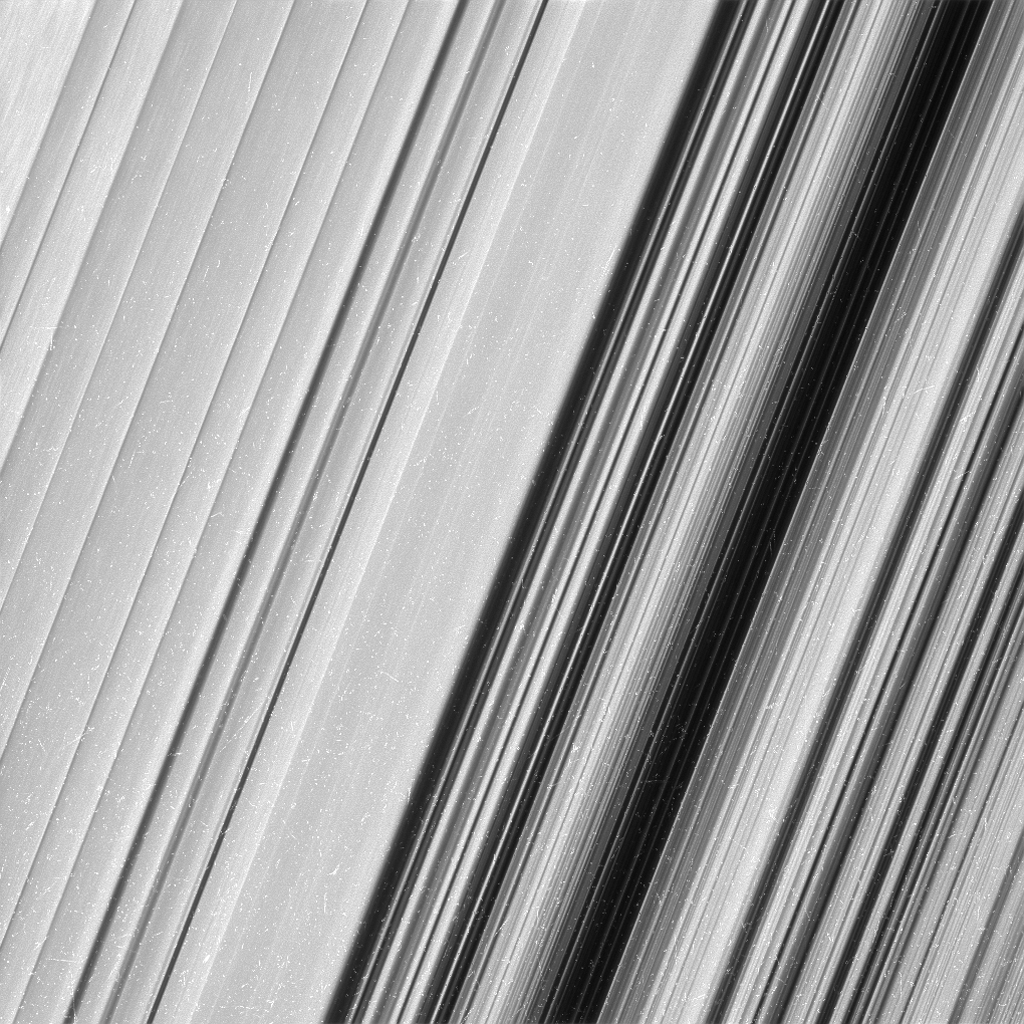 http://www.jpl.nasa.gov/news/news.php?feature=6729
|

 Posts:
Posts: 35256
 Posted: Posted: Wed Feb 01, 2017 5:04 pm
|

 Posts:
Posts: 18770
 Posted: Posted: Thu Feb 02, 2017 3:20 am
I really do love and enjoy this stuff. Keep it up DrCaleb.  
|

 Posts:
Posts: 51961
 Posted: Posted: Thu Feb 02, 2017 8:11 am
stratos stratos: I really do love and enjoy this stuff. Keep it up DrCaleb.   Space is big. There is always something new out there. ![Drink up [B-o]](./images/smilies/drinkup.gif)
|

 Posts:
Posts: 51961
 Posted: Posted: Thu Feb 02, 2017 8:13 am
$1: Outstanding Opportunity Rover Making ‘Amazing New Discoveries’ 13 Years After Mars Touchdown – Scientist Tells UTNASA’s truly outstanding Opportunity rover continues “making new discoveries about ancient Mars” as she commemorates 13 Years since bouncing to a touchdown on Mars, in a feat that is “truly amazing” – the deputy chief scientist Ray Arvidson told Universe Today exclusively. Resilient Opportunity celebrated her 13th birthday on Sol 4623 on January 24, 2017 PST while driving south along the eroded rim of humongous Endeavour crater – and having netted an unfathomable record for longevity and ground breaking scientific discoveries about the watery environment of the ancient Red Planet. “Reaching the 13th year anniversary with a functioning rover making new discoveries about ancient Mars on a continuing basis is truly amazing,” Ray Arvidson, Opportunity Deputy Principal Investigator of Washington University in St. Louis, told Universe Today. Put another way Opportunity is 13 YEARS into her 3 MONTH mission! And still going strong! During the past year the world famous rover discovered “more extensive aqueous alteration within fractures and more mild alteration within the bedrock outcrops” at Endeavour crater, Arvidson elaborated. And now she is headed to her next target – an ancient water carved gully! The gully is situated about 0. 6 mile (1.6 km) south of the robots current location. But to get there she first has to heroically ascend steep rocky slopes inclined over 20 degrees along the eroded craters western rim – and it’s no easy task! Slipping and sliding along the way and all alone on difficult alien terrain. Furthermore she is 51 times beyond her “warrantied” life expectancy of merely 90 Sols promised at the time of landing so long ago – roving the surface of the 4th rock from the Sun during her latest extended mission; EM #10. 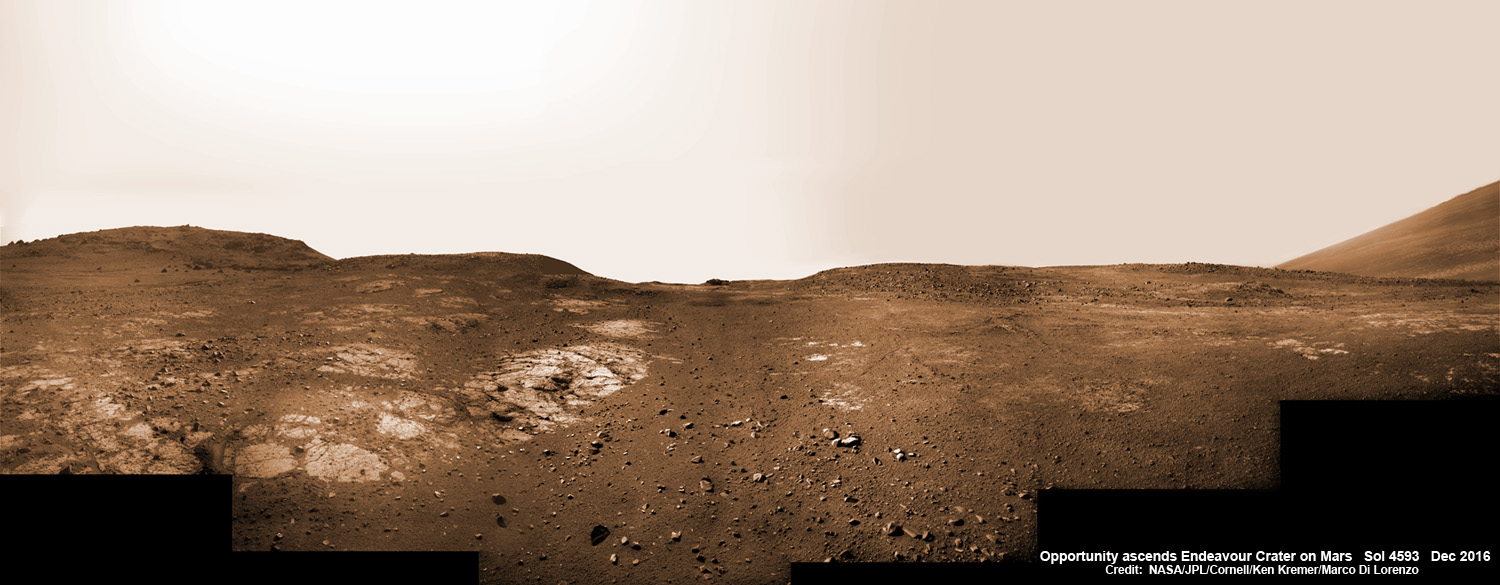 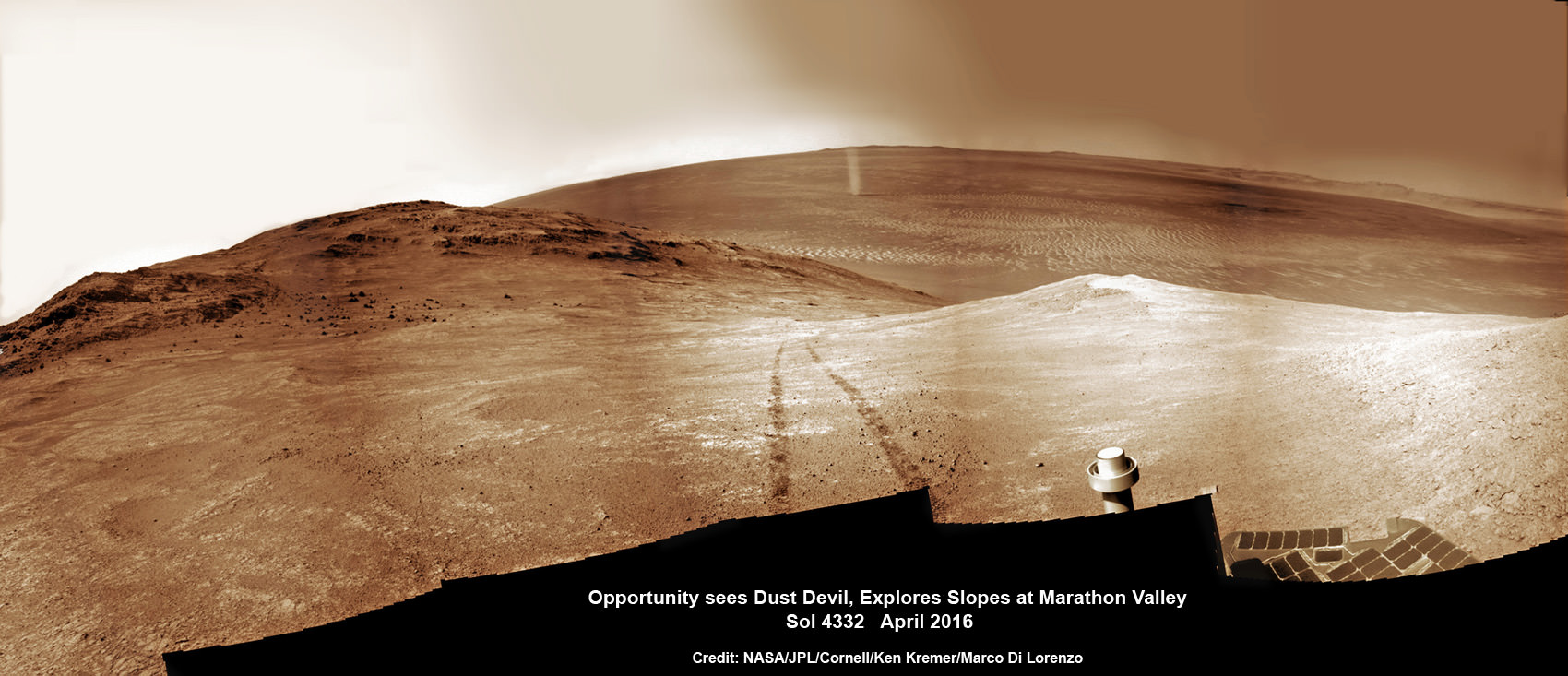 http://www.universetoday.com/133012/out ... touchdown/
|

 Posts:
Posts: 15594
 Posted: Posted: Thu Feb 02, 2017 7:12 pm
DrCaleb DrCaleb: $1: Close Views Show Saturn's Rings in Unprecedented Detail
...
I saw this on CBC's website where they had a few images posted. Very cool! I'm looking forward to the future images Cassini provides as it gets even closer and passes through the rings.
|

 Posts:
Posts: 51961
 Posted: Posted: Fri Feb 03, 2017 11:23 am
$1: Milky Way is not only being pulled—it’s also “pushed” by a voidYou may not notice it, but our Milky Way galaxy is cruising along at 630 kilometers (~391 miles) per second. That speed is often attributed to the influence of a single gravitational source. But in a new study, a group of researchers has found that the motions of the Local Group—the cluster of galaxies that includes the Milky Way—are being driven by two primary sources: the previously known and incredibly massive Shapley Supercluster and a newly discovered repeller, which the researchers dub the Dipole Repeller. Shapley’s contribution was already known, but the Dipole Repeller’s hadn't been recognized prior to this study. The researchers plotted the motions of many galaxies in the nearby Universe in a 3D model, using data from the Cosmicflows-2 database. Since the Universe is expanding, most galaxies are moving away from ours, creating a red-shift in the light they emit. But since the researchers were more interested in the other influences on a galaxy’s motion, they simply subtracted the expansion’s contribution. The resulting plot shows what the motions of galaxies would look like if space wasn’t expanding. 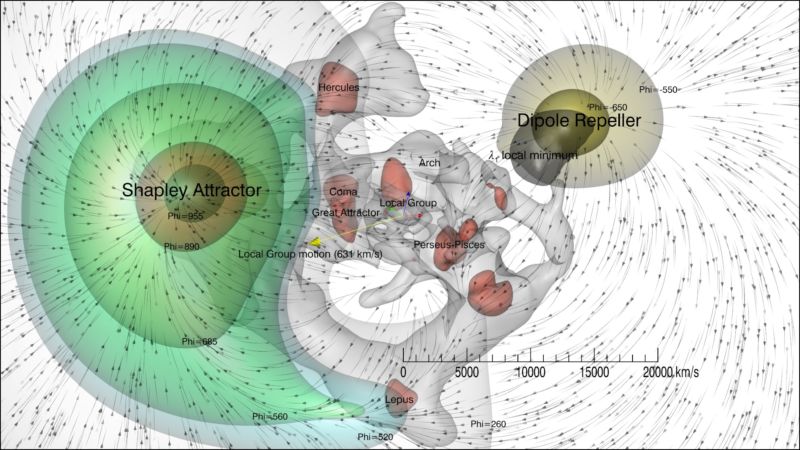 $1: Labeled 3D model. The little arrows are galaxies, and the lines coming from them depicts their velocities (with the influence of the Universe's expansion on their velocities removed). Our galaxy, the Milky Way, is located in the Local Group, near the center of the image. The motions of all the galaxies seen here are dominated by the Shapley Attractor and the Dipole Repeller.  $1: The model, showing the flow of galaxy velocities (blue) and the anti-flow pointing back the way the galaxies came, toward the Dipole Repeller (red). 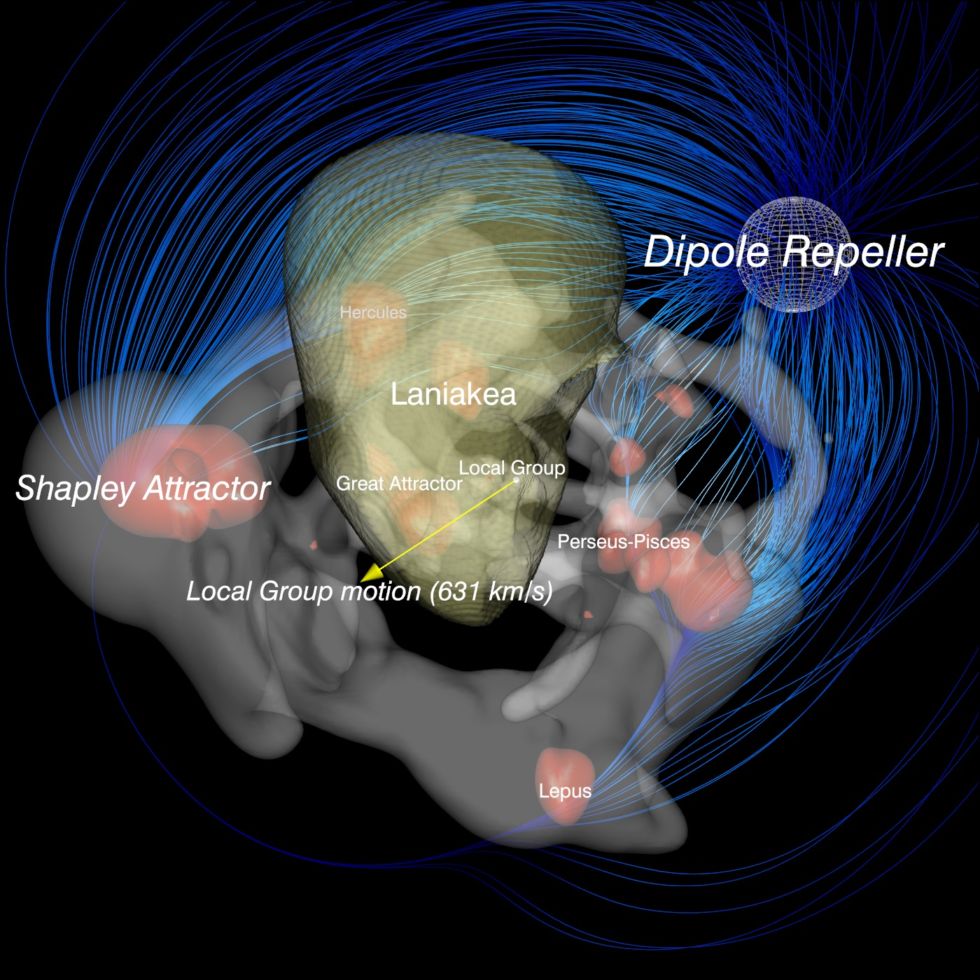 $1: The flow, showing where the Laniakea Supercluster is located. The Local Group—and hence our Milky Way galaxy—is part of Laniakea. https://arstechnica.com/science/2017/02 ... by-a-void/
|

 Posts:
Posts: 51961
 Posted: Posted: Fri Feb 03, 2017 11:26 am
A long article, and not too bad on the jargon. It's goes through what we know, and what we don't. $1: A history of dark matterAcross decades, the hunt for a dark matter particle has looked at many possible solutions—but so far, humanity hasn’t produced a clear answer. Is dark matter a neutrino? An axion? A figment of our imagination? Scientists don’t agree, though experiments from XENON to ADMX continue to strive towards giving us an answer. “We have to be extremely open-minded about what it might be,” James Bullock, a professor of physics and astronomy at UC Irvine, told Ars. “Dark matter could be even more interesting than we were thinking it was going to be 20 or 30 years ago.” The built-up confusion surrounding dark matter today can be extremely hard to parse. Recent headlines declared dark matter may not even exist, and even dedicated followers could be forgiven for asking how scientists came up with the idea in the first place. So to better understand dark matter’s place in the Universe, it may be helpful to take a look back at how our ideas about this mysterious material started and evolved over time—it's time to traverse a condensed history of dark matter.  $1: The Bullet Cluster, which has been viewed as a demonstration of dark matter. https://arstechnica.com/science/2017/02 ... rk-matter/
|

 Posts:
Posts: 18770
 Posted: Posted: Wed Feb 08, 2017 2:10 am
Milky Way is not only being pulled—it’s also “pushed” by a void Seen a vid on this yesterday while CKA was down. Loved it and found it so fascinating. In only a few million light yeas we will be in cluster housing with a bunch of other Galaxies. The universe is a Social Liberal 
|
 
|
Page 105 of 237
|
[ 3542 posts ] |
Who is online |
Users browsing this forum: No registered users and 13 guests |

|
|

